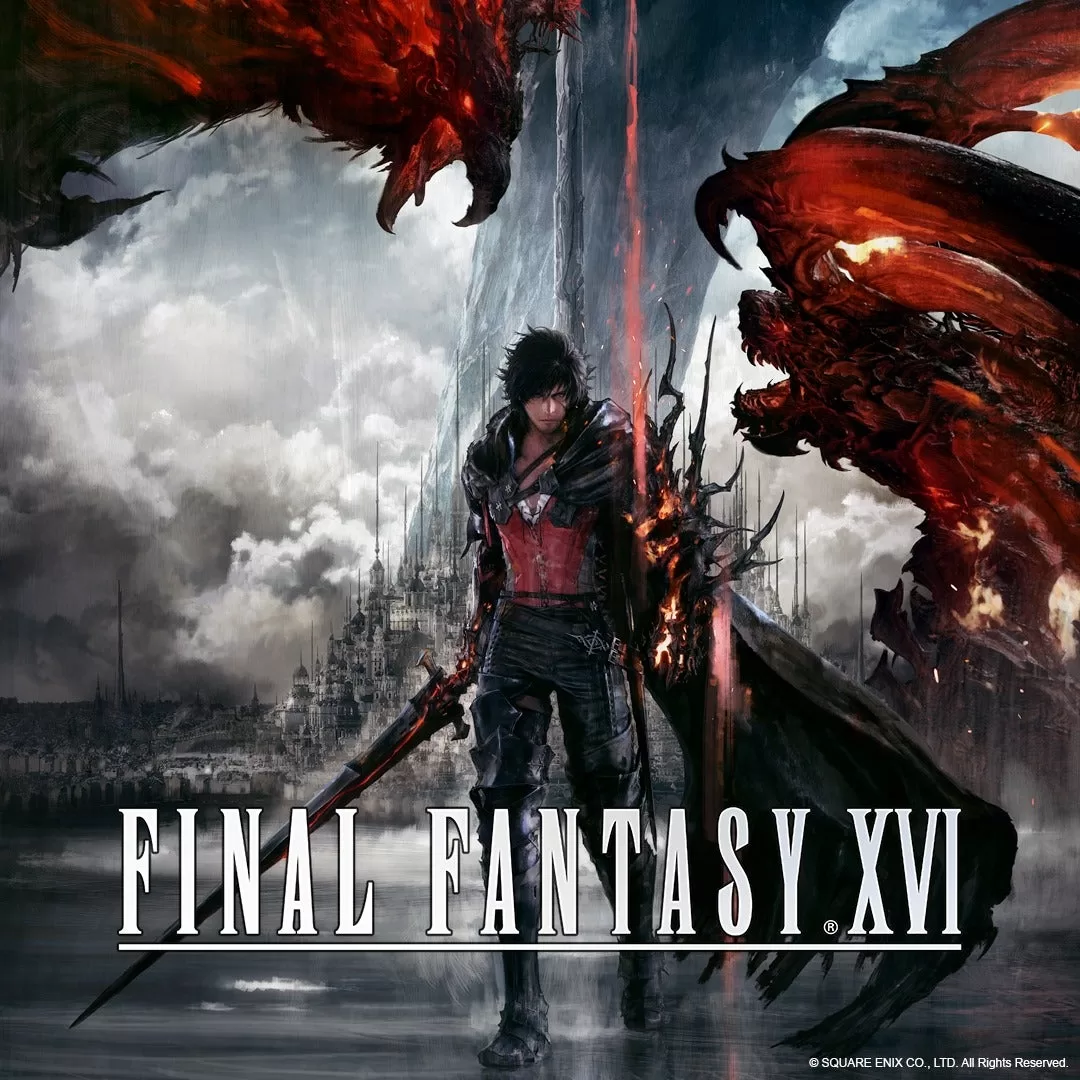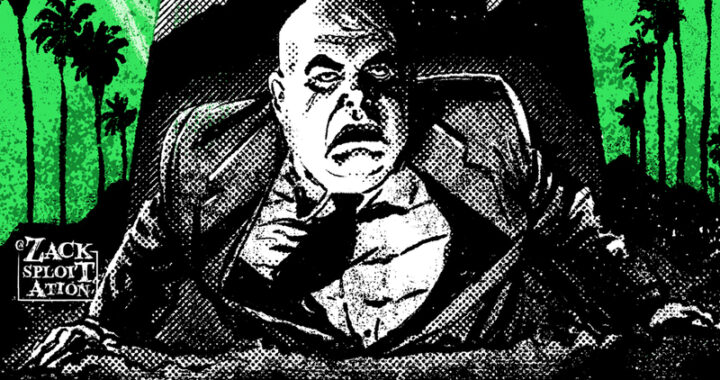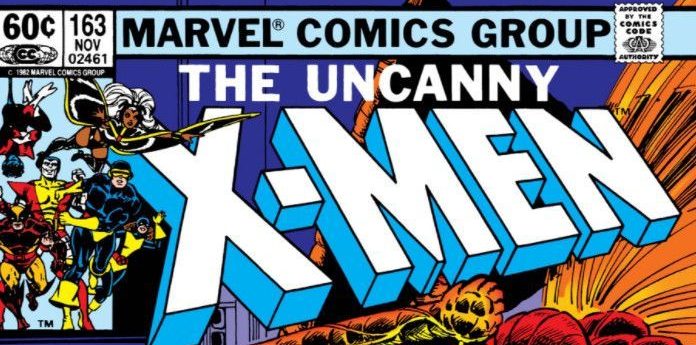
“Seduction of the Innocent”: A Retrospective of Claremont’s X-Men, Part 9
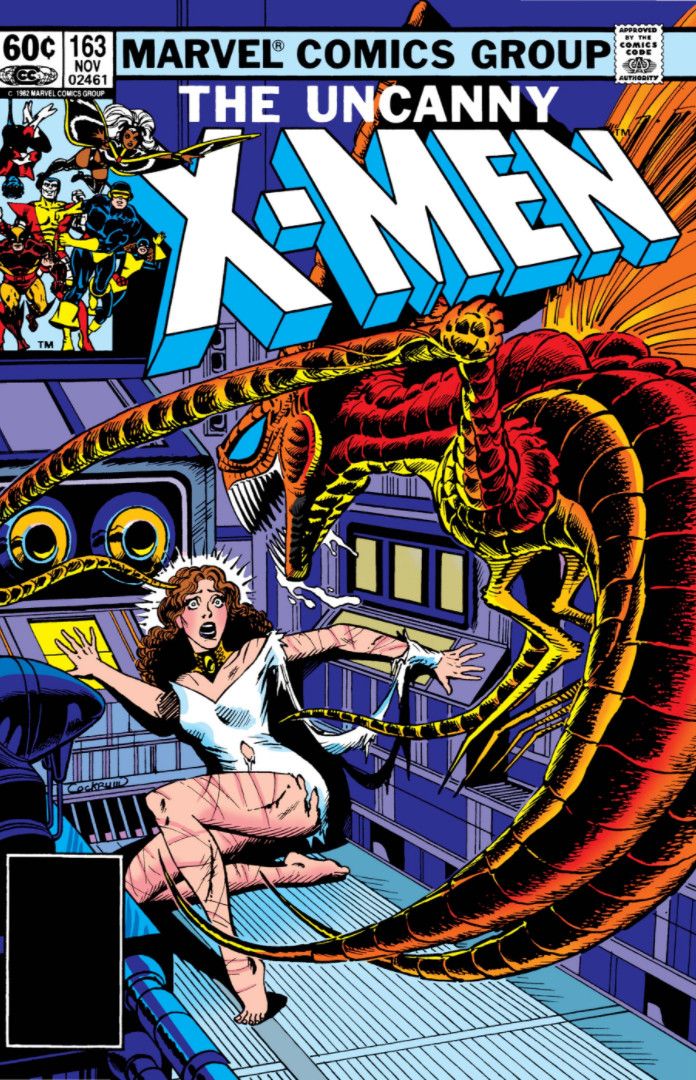
When looking through the issues leading up to the Brood Saga, I“m reminded of Fredric Wertham“s infamous book, Seduction of the Innocent. Not because that was the book that led to censorship within the comic book industry, though Wertham probably would have been shocked at some of Claremont“s stories if he“d read them at the time. No, it“s relevant for our look at Chris Claremont“s work during this period because this is where he delves deeply into the classic style of horror comics, a major catalyst for that book. Though Claremont is not really known as a horror writer, he wrote several of Marvel horror titles and he knew how to tap into primal fears to inspiring effect. Indeed, the seduction of the innocent is a major theme of Claremont’s writing around this time.
This is a period of his Uncanny X-Men run where Claremont has the X-Men encounter some truly infamous monsters. Some of them are of the human variety, like the brutal, repressive fascism represented by HYDRA and Baron Wolfgang von Strucker. Others are more classic horror monsters, like Count Dracula and the demon sorcerer Belasco. All of this culminates with the X-Men“s brush with death and their deadliest encounter with the Brood, based heavily on H.R. Giger“s Xenomorph from the Alien series. These monsters are all frightening in different aspects, driven by human fears that connect to what the X-Men represent.
This period begins with the X-Men“s classic first encounter with Dracula, and they would battle each other twice during Claremont“s tenure. The first meeting is easily the most memorable, largely because it taps into the power of Bram Stoker“s original novel. Claremont taps into the suspense and the pacing that makes the novel work, and his Dracula evokes many of the same fears that Stoker originally drew upon. Like Stoker“s Dracula, this version stalks women in the night, masks his presence, as his victims steadily become weaker and more vampiric. Likewise, a group of intrepid hunters, driven by the love of one of Dracula“s victims, hunts the vampire lord to his lair where there is a climactic confrontation. While not a panel-for-panel remake of the novel, the threads of the book are present in this story, and that lends strength to Claremont“s narrative. This Dracula feels like the same monster that opposed Van Helsing, though he“s also the same character from Tomb of Dracula, which likewise drew on Stoker to build the Marvel version.
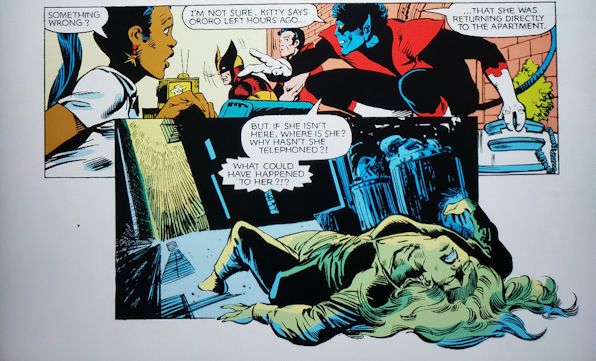
At the same time, this is also definitely an X-Men story, and Claremont spins the Dracula narrative to make it his own. Claremont has long had the habit of making his primary female characters the object of desire for the villain, and that trope returns here. In this case, though, it is forgivable because it fits neatly with Dracula“s modus operandi. Dracula is not a traditional supervillain””he is a seducer, a tempter, a Devil figure that offers eternal life at the cost of one“s soul. Indeed, his very name invokes the Devil. Dracula is the son of Drakul (meaning “dragon”“), and he was a member of the Order of the Dragon. Dragons were associated with the Biblical Satan, who once assumed the form of a dragon. Also, like Lucifer, Dracula is a fallen hero whose pride leads him to evil and darkness. Claremont“s Dracula is very much written as a villain in the Satanic mold. This Dracula seduces Storm, much as he did with Mina Murray, draining her blood and offering her the chance to join him as his eternal bride.
Where Claremont deviates somewhat from the classic formula is that this story is also about faith, and that faith manifests in different ways throughout the issue. Primarily it“s about the faith that the X-Men have in Ororo, and how that faith leads her back to the light and away from Dracula. This is especially true with Kitty Pryde, who doubts Ororo after she initially begins to change after Ororo is bitten by the vampire. It“s when Kitty reaffirms her faith in her mother figure and risks everything that Ororo comes back to her. At the same time, this story addresses various forms of religious faith and how faith is used to repel the monster. No one can use the cross against Dracula except Nightcrawler, the devout Catholic, who drives the monster away in one notable panel. Kitty attempts to use the cross against Dracula but fails, while her faith in Judaism (represented by her Star of David necklace) burns the monster when he attempts to grab her by the throat. The other X-Men have very different belief systems””Ororo“s belief in the Bright Lady, Peter“s belief in Soviet Communism, and Logan“s belief only in what his senses tell him. However, the one thing that binds them is their belief in the X-Men and what they represent, as well as their belief in each other as a family. This, in the end, is what allows Ororo to reclaim herself (she always chooses freedom over servitude or confinement), and break Dracula“s hold over her will.
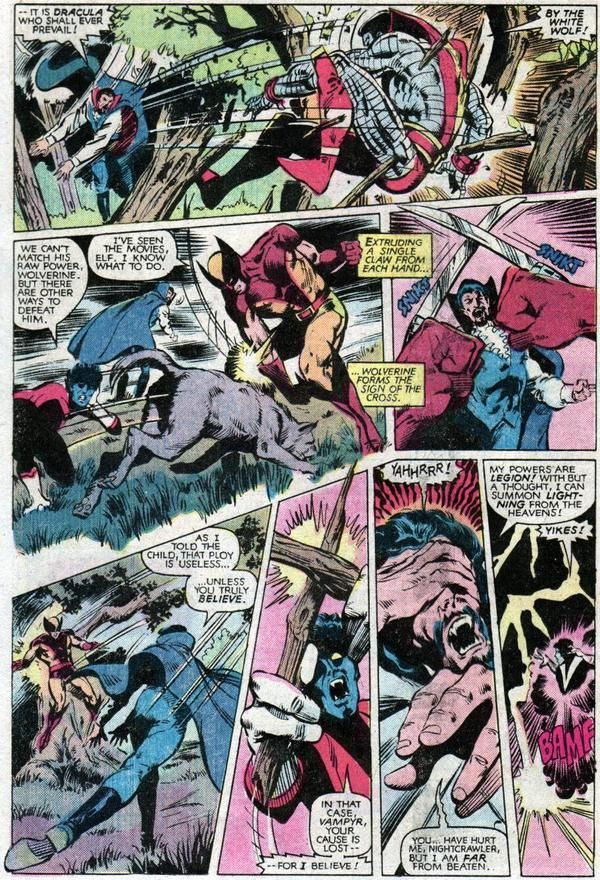
The art is also worth noting, as it“s beautifully atmospheric and even Gothic at times. This was one of Claremont“s first and most notable collaborations with the legendary Bill Sienkewicz, and they“d eventually work together during their defining run on The New Mutants. Before that, Sienkewicz would do fill-in issues such as this one, and his bizarre surreal visual style lends itself very well to a horror comic. His Dracula is quite majestic as well, and Sienkewicz creates a powerful tone of Gothic horror that Claremont“s script tries to evoke. When Storm is found in the alleyway after being attacked by Dracula, the artwork implies the violence of the scene without ever showing it on panel. Early in the issue, Storm is a strong, regal presence, but in this frame, Ororo is reduced to a weak and anemic shadow of herself. It“s a beautiful comic to read, and Claremont was able to bring out Sienkewicz“s strengths as an artist in this issue.
Claremont follows this issue up with one of his greatest origin stories, the introduction of Magik. Illyana Rasputin begins this issue as a six-year-old girl, the younger sister of Colossus. By this time, the X-Men had relocated back to the island that the team had seized from Magneto ten issues ago. They hadn“t had a consistent home around this time, since the X-Mansion was destroyed by the alien Sidri. After that, they“d essentially settled into Magneto“s former island, a place that the team knew very little about even after living there for some time. The team ends up paying the price for that this issue, as it“s a place with weak dimensional walls. This allows Belasco to reach out to Illyana from his hell dimension of Limbo, and it“s here where Chris Claremont tells one of his darkest and yet most subtle tales.
When I first read both this and the Magik limited series that fills in the continuity gaps in between this issue, I made very little of Claremont“s story. It was enjoyable and creepy in the right ways, but I didn“t grasp how far he was pushing with this story, and how much Claremont was bending the Comics Code (which Marvel still followed back in those days). Looking at it with fresh eyes now, it“s clear that Claremont was telling an allegorical story about child abuse and exploitation, using demonic corruption and stolen innocence as a metaphor for crimes against children. Claremont hints at it very strongly even here, especially in his portrayal of the demonic and corrupted Kurt, who attempts to molest Kitty in one deeply disturbing scene. It is extremely difficult for me to read these issues now, I confess, but that“s because Claremont was so effective at making Belasco a depraved and disgusting villain. Belasco, as written in this story and in the Magik LS, is perhaps one of the most vile, repugnant characters Claremont has ever written, and he created Mister Sinister, the Shadow King, and Reverend Stryker. Belasco truly makes my skin crawl in a way no other X-villain does, and that is an impressive achievement for a villain. Indeed, one would likely have to read a Garth Ennis comic to find a villain that is objectively more repulsive than Belasco is here.
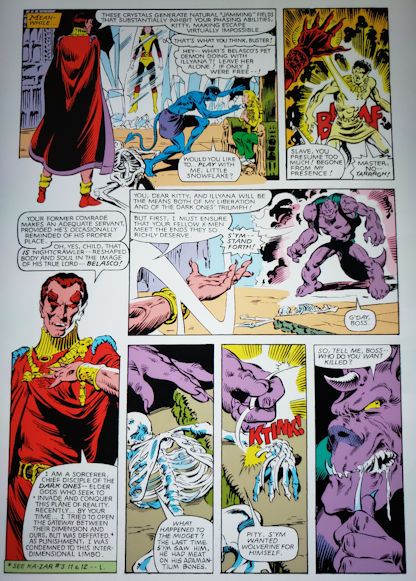
Moreover, Belasco manages to succeed at something not even Dracula was able to do. He successfully corrupts the X-Men, turning them into monstrous shadows of their former selves. Granted, these are time-displaced alternate future versions of the X-Men that were trapped in Limbo, and not the real X-Men. Still, they are still recognizably the X-Men for all that these time-displaced versions are only a glimpse into the X-Men“s future. Kurt is still every inch the swashbuckler who loves the ladies, but Belasco turns him into a sexual predator who serves as Belasco“s unwilling enforcer. Ororo, who has grown into an elderly sorceress, has lost her strength but none of her will, though part of herself has been consecrated to darkness. Even Kitty, who represents innocence and purity, is turned into something monstrous, though we don“t see her fate here. Those that do not submit to corruption are simply killed by Belasco“s pet demon S“Ym, and Logan and Peter do not survive to see this horrifying future. In some respects, this future is even more nightmarish than Days of Future Past, as at least the DoFP X-Men died honorably and with their souls intact. Their deaths mattered because they died so that the future could be changed. The Limbo future X-Men, in contrast, are broken, damned, and pitiable. They fail to protect Illyana, and their deaths accomplish nothing of worth. This may perhaps be the X-Men at their absolute lowest point, even if they are not the X-Men we know.
Still, Claremont presents a glimmer of hope even in the darkness of Limbo, and in the end, Belasco does not truly succeed. The younger X-Men represent the hope that their future can be changed, and the older sorceress Ororo provides the knowledge and wisdom they need to escape Limbo. The future Ororo subtly gives her younger self the artifacts she needs to stand up to Belasco, then joins the battle in the hopes of changing the future. The younger Kurt overcomes his older self, pretends to be Belasco“s servant, and then uses the opportunity to strike at the right moment. Older Storm stays in Limbo, agreeing to provide cover to the younger X-Men as they escape with Illyana. For a moment, they nearly succeed, as Kitty loses her grip on child Illyana”¦ only to rescue Illyana in the next instant as a thirteen-year-old girl. At this point, Illyana is truly Magik, though she hides the truth of her demonic heritage from the X-Men. She would not admit who and what she“s truly become until she joins the New Mutants, and her full history is explored in the Magik limited series.
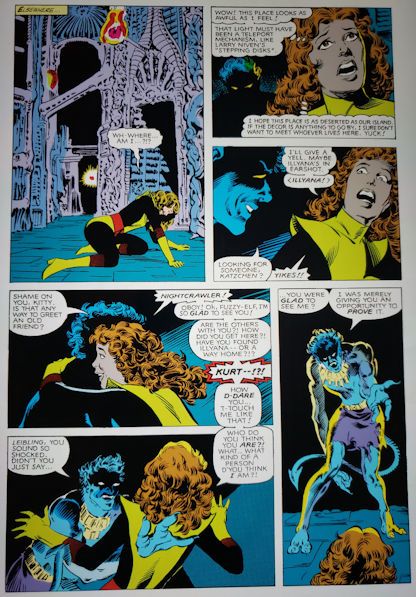
This issue reunited Chris Claremont with Brent Anderson, who had already done a previous fill-in on Uncanny X-Men. There, as here, Anderson“s work lent itself nicely to horror, even if he“s better known for drawing classic superheroes and “everyday perspective”“ stories. Anderson would go on to do God Loves, Man Kills (which we“ll discuss in a later installment, as well as the recent Director“s Cut version), eventually gaining prominence as the main series artist on Kurt Busiek“s Astro City. Though Anderson is not famous for the macabre and the Gothic like Bill Sienkewicz is, his Limbo looks claustrophobic, dismal, and creepy. The design of the hell dimension of Limbo takes on an aesthetic that evokes Lovecraft and H.R. Giger. Limbo looks unsettling and disturbing, perfectly suiting the story that Claremont tells in this issue. Brent Anderson is an underrated artist in general, but his X-Men work tends to be overlooked here especially.
All in all, this issue is excellent, though I have misgivings about the story the more I look back at it. Not because this is not a good comic””it“s technically excellent, even though it deals with some convoluted and tangled history, as well as time travel and difficult themes. No, this story impacts me because it is so good that it makes me feel grimy after having read it. Claremont and Anderson do such a good job of making Limbo a desolate place, such an excellent job of making the villains offensively evil, that this is a story best followed by a long, refreshing shower. This is a comic that embodies a primal adult fear, the abduction and violation of an innocent child. This fear is realized so effectively that it disturbs and repulses me on a moral level. There are not many comics that can creep me out to this extent, and the creators deserve high praise for their work here.
As a final note, I“d be amiss not to discuss S“Ym, the demon that Claremont introduces as Belasco“s deadly enforcer. Claremont intended this character as a subtle nod to Cerebus the Aardvark, a character that had become popular during the 1980“s. The name gives this away most obviously, as it references Cerebus“s controversial creator, the writer/artist Dave Sim. Like Cerebus, S“Ym wears a similar outfit and even uses similar speech patterns, though they are otherwise different. The demonic S“Ym briefly becomes a memorable character in his own right, usually menacing the X-groups during Limbo-related storylines. S“Ym eventually makes his return, but very rarely in the main X-Men title. He does, however, feature occasionally in New Mutants, usually as a rebellious demon who pretends to “serve”“ Illyana until he turns against her during Claremont“s final Magus arc. S“Ym eventually fades into obscurity over the years following Claremont“s run, but he“s an important part of Illyana“s larger story towards the beginning.
Dave Cockrum returns with this issue, but the content of this issue is no less horrifying for the fact that Claremont moves away from the supernatural. His brighter and more whimsical style is welcomed after the darkness and gloom of the past two issues, as excellent as they are. Claremont is still diving into dark places with this issue, but it“s somewhat more hopeful. It helps that Xavier is essentially the central character, as his faith in humanity is very much needed for a tale like this.
At this point, Charles Xavier is still recovering from a coma induced by the Brood (which unknown to the X-Men is gestating inside Xavier“s body). The X-Men fail to rouse the Professor from his Brood-induced slumber, which leads to a harsh disagreement between Storm and the returned Cyclops. Scott is at fault in the exchange””his words are needlessly harsh, driven by his own frustration at not being able to deal with his own issues or help the Professor. However, Scott“s true character shines through as he eventually recognizes this, apologizes to Ororo, and asks to lean on her for support with his problems. This is a step forward for Scott, who tends to bottle up his emotions until he can“t contain them. To Ororo“s credit, she accepts the apology and is willing to move forward, and she comes across as a caring and compassionate woman beneath the goddess front she wears.
Following this, most of the issue takes place during a flashback to Xavier“s time in Israel. The story does a good job of placing the timeline of his past, indicating that this took place after his encounter with the Shadow King, but before his legs are crushed by Lucifer. However, it sheds some important light on Xavier, since this is his first meeting with Magneto, and their introduction is innocuous considering what they become to each other later. This is also the first appearance of Gabrielle Haller, who plays an important part in Xavier“s life. Xavier has been brought to Israel to deal with Haller“s case, since she“s been rendered catatonic by a traumatic event in her past. Gabrielle was a young Jewish woman who had suffered during the Holocaust at the hands of the Nazis, and her mind retreated to escape the pain and trauma they“d caused during the war. Through telepathic therapy, Xavier manages to bring Gabrielle back to consciousness, though she“s initially very dependent on him for emotional support.
Charles Xavier is a character who very often is treated as a villain in modern portrayals, usually due to moral lapses we see in his past. His actions this issue contribute to that view, and his behavior here is extremely questionable to be kind about it. Charles gets emotionally involved with Gabrielle, uses his position of trust to become closer with her, all in violation of his ethics as a telepath and his position as her therapist. Charles even admits (if only to himself) that it is a breach of ethics to get romantically involved with a patient, yet he still pursues the relationship. In fairness, Claremont is fully aware of this, and he does confront Xavier with the consequences of his actions later in New Mutants. Xavier“s affair with Gabrielle eventually results in the birth of their son David Haller, also known as Legion, a powerful psionic with Dissociative Identity Disorder. At this point, though, Charles is unaware that he“s fathered a son, nor does it occur to him to check on Gaby afterwards. This is a moment that sets up a fascinating New Mutants story, but it casts Charles is an unflattering light, as good as the story is otherwise.
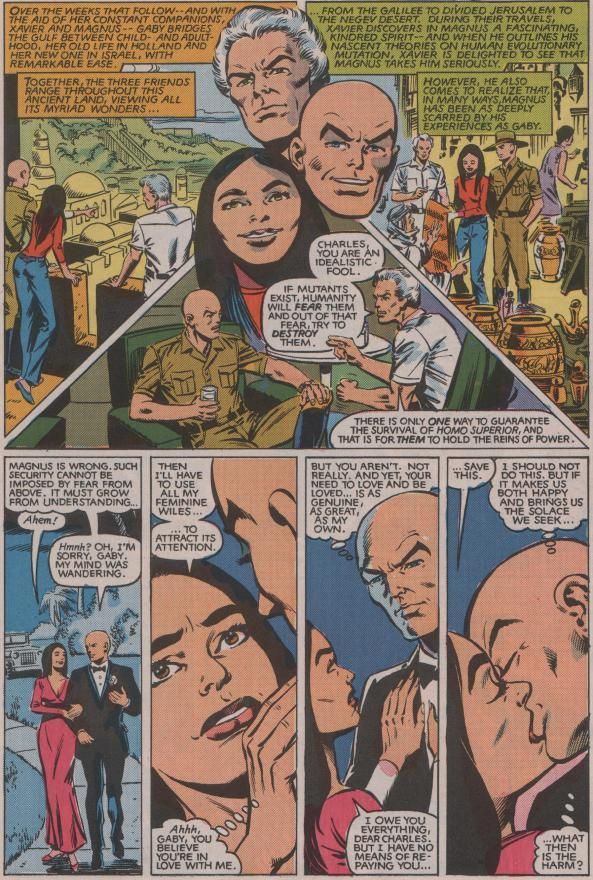
Gabrielle“s awakening is a new lease on life for her, but it presents an opportunity for HYDRA, the villains of the piece. Baron Wolfgang von Strucker turns out to be the Nazi responsible for Gaby“s catatonia, which was inflicted intentionally to hide a vital secret””the location of a cache of secret Nazi gold. Here, Claremont is drawing on an interesting piece of genuine history, as the Nazis did steal wealth from the Jewish people during the Second World War. Nazi gold trains legitimately existed, and it“s entirely plausible that the Nazis could have hidden gold deposits, based on loot they stole from the people they victimized. In this story, Gaby is the key to locating one of these lost gold deposits, one that Strucker plans to use to finance his villainous ambitions. HYDRA agents kidnap Gabrielle, leading Xavier to team up with Magneto to rescue her. It“s the kind of adventure that could have been the basis of one of the later Fox X-Men movies, and this story may have inspired the Charles/Erik dynamic in those films.
Xavier and Magneto“s dynamic is the driving force behind this flashback adventure, and it“s enjoyable watching them interact. Their friendship seems genuine, and they do share a sense of camaraderie in their interactions with each other. However, Claremont also hints at the later fracture between the two friends, as we see the deep ideological differences between Xavier and Magneto. Charles sees the best in humanity and seeks brotherhood with them, while Magneto only sees the worst after his traumatic experiences in the concentration camp at Auschwitz. It“s at this point where Magneto“s experiences in Auschwitz define him more under Claremont“s pen, possibly echoing Claremont“s own past experiences in Israel when he visited there as a political science student. Still, both arguments are balanced, and as interesting as Magneto is, he doesn“t completely dominate the story.
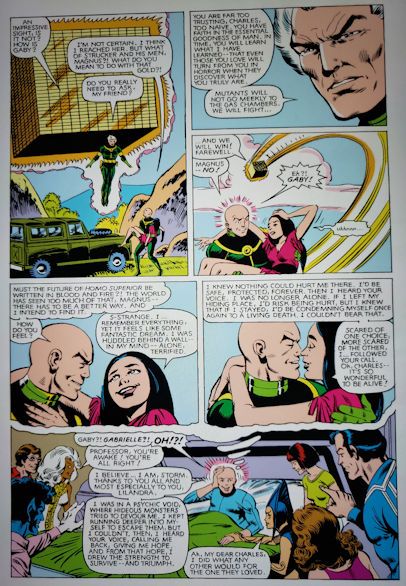
Eventually, the HYDRA agents are defeated by Xavier and Magneto. In truth, Strucker doesn“t stand a chance, since threatening the Master of Magnetism with a metal weapon like the Satan Claw is never a wise idea. However, Strucker and HYDRA are largely a catalyst and an external threat to motivate the real conflict””Xavier“s growing disagreement with his old friend Magnus. While Magneto is more than happy to help Xavier rescue his love interest, his real goal is acquiring the Nazi gold for his own ambitions. Since Charles cannot stop Magneto, he simply lets him go, and the two go their separate ways. In the end, this helps resolve an outstanding question about Magneto, as it explains how Magneto acquired the resources to build asteroid bases and advanced scientific equipment for his plans. In another sense, it seems right for Magneto to claim the gold, as the Nazis stole that wealth from his own people. Perhaps Magneto views it as a sense of justice after the evil done to him, his family, and his people. Though as we would see later, it is nowhere near enough to sate Magneto“s desire for blood and his hatred of his persecutors.
At the end of this issue, Charles finally awakens and reunites with the X-Men that have been watching over him. This leads to a farewell banquet and a celebration, as Lilandra plans to leave Earth again to return to the Shi“Ar Empire. However, Deathbird has other plans, as she employs the Brood once more. This time, the X-Men are ambushed at dinner, and a stasis bomb knocks the X-Men into unconsciousness before they can react to the threat. This leads into the Brood Saga, which is considered one of the better regarded arcs of the post-Byrne period of Claremont“s Uncanny X-Men. This is also the final arc drawn by Dave Cockrum, as he hands over the reins to Paul Smith, who completes the final issues of the Brood Saga.
Strangely enough, for all its reputation, The Brood Saga is one of those X-Men arcs that I tend to overlook in the larger mythos. Not because it isn“t a quality story or because it doesn“t have anything worthwhile to say””it is and it does. I suspect part of it is that I came into this story much later than many other stories in the Claremont canon, and it doesn“t stand out in the way that stories like Dark Phoenix or the Asgardian Wars do. There are issues and character points that I quite enjoy, though””Wolverine gets some really good moments in this and Carol Danvers finally gets a chance to shine in this series. Still, the Brood Saga is one of those stories that, while effective at what it does, tends to slip through the cracks in my memory more often compared to other Claremont stories. In fairness, the Brood Saga is easily the best of Claremont“s Brood stories, and this is the best portrayal of the Brood as villains in the series. By no means let me discourage you from reading the Brood Saga, as it is a high point for the book in many aspects.
Another odd aspect is that the first issue of the Brood Saga is easily my favorite part of the story. Claremont begins with Wolverine being chased across the surface of an alien world by the Brood. Logan is alone, on the run, hunted by the Brood, and unable to rely on the X-Men for help. Worse, we learn later in the issue that the X-Men have all been implanted with Brood eggs, and each of them is slowly dying as the parasite gradually takes them over. The only reason Wolverine is strong enough to fight is because his healing factor and adamantium skeleton allow him to resist the Brood infection. The X-Men are being mind-controlled by the Brood and don“t realize they“ve been taken over, adding to the sense of isolation and fear. The basic premise is solid, but what makes this issue so good is the presentation and how Claremont and Cockrum slowly unfold the events of the story. The issue is extremely dreamlike, shifting through memory and illusion, as Wolverine struggles to decide what“s real and what“s illusion. Claremont“s internal monologue as Wolverine takes firm hold here; it“s around this time that his Wolverine internal captions began to be a regular narrative device in the series.
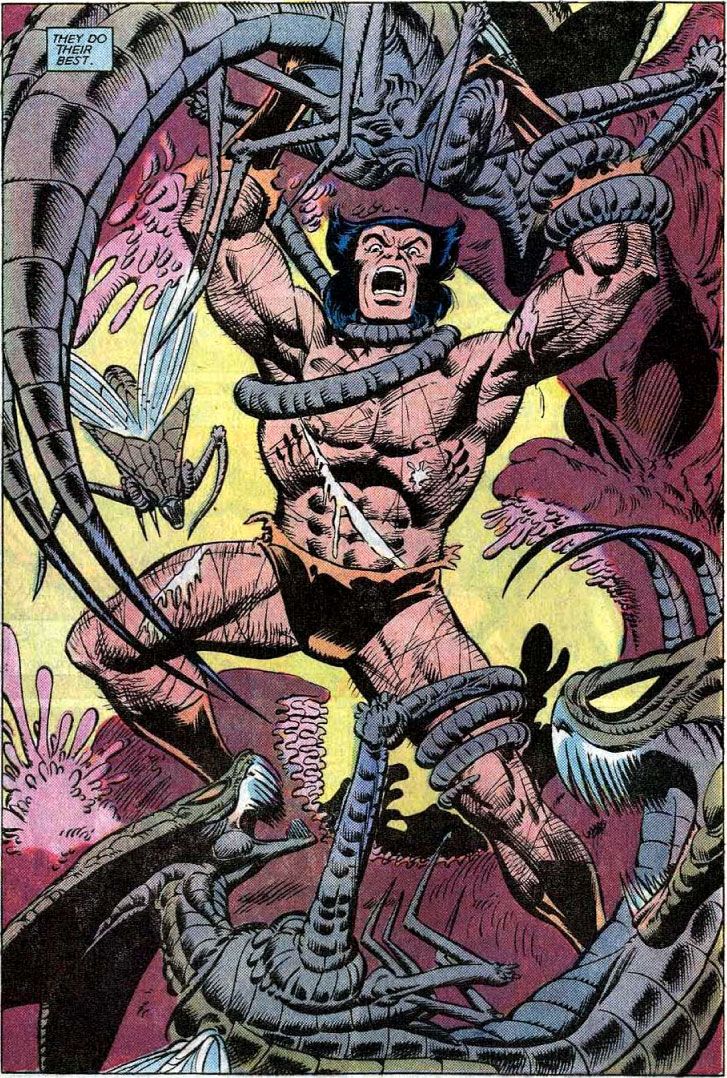
Dave Cockrum is on his finest form at the end of his second run, and his work is generally mesmerizing to look at. Cockrum“s art in this issue is some of his best, including his splash pages of the Brood-implanted and battle-damaged Wolverine in action. However, his depiction of the alien landscape and the Acanti whaleship carcass are stunning to look at, setting the scene while also being horrifying. Cockrum“s panel arrangement and keen eye for the bizarre contribute to the dreamlike look and feel of this story, and his work here can“t be underestimated. Everything looks and feels alien, and the sense of the unknown in the visuals drives the horror aspects of the Brood story. Even Cockrum“s depiction of Logan after killing the Brood Queen that“s been gestating inside of him makes a strong impact. Logan looks haggard, worn down by the Brood, and still feeling the effects of the implantation.
Violation is another theme that Claremont revisits regularly during this phase of the book, and he returns to that with the Brood Saga. Claremont gives a light touch to the idea that the X-Men have been violated by the Brood, but he doesn“t walk away from the emotional consequences of that fact. When Logan talks about shame fueling his rage, it“s clear that Claremont means the shame that comes from being assaulted and implanted by the Brood. It raises the question whether Logan is in a worse position because he realizes the truth and must live with that reality, rather than living in the blissful denial of the Brood“s mind control. Logan seems to recognize that it is a form of mercy, in a sense, and so he faces the Brood alone and doesn“t try to break their hold on their minds.
Eventually, the Brood egg is defeated through a supreme effort of Logan“s will, his adamantium-laced body, and his healing factor. Claremont often showed Logan struggling with pain during his run, as opposed to the nearly invincible portrayal he often gets in later runs. However, this story is largely about the X-Men“s relationship with death, and Logan“s struggle against the Brood parasite may be one of the worst points he“s been in physically. Logan survives because of his powerful will to live, fueled by his savagery and his primal, animal urge for survival. With the Brood egg destroyed, Logan resolves to rescue the X-Men and turn the tables against the Brood.
The next issue is a standard issue, more by-the-numbers plot as the X-Men escape from their Brood captors. The X-Men eventually free themselves from the Brood mind control, making their way to Lilandra“s space yacht with help from Wolverine. The most interesting aspect of this is Logan“s decision not to tell the X-Men about the Brood implantations. Aside from Logan, they believe they“re perfectly healthy, but deep down they“re slowly dying from the Brood infection. This adds to the usual tension between Cyclops and Wolverine; Scott is inclined to show mercy even to the Brood, while Logan is more violent and bloodthirsty than usual. It“s easy to sympathize with Logan“s desire to kill his enemies in this case; from his perspective, Logan is avenging his dying teammates as well as his own pain. Scott doesn“t understand the extent that Wolverine is suffering, or his understandable reasons for wanting to kill the Brood for what they“ve done. Kitty also accidentally kills an attacking Brood by sending it out the airlock, something she didn“t intend to do. It“s an issue that strikes the X-Men“s morality and raises tension, but otherwise is an issue that moves the plot along rather than hits deep character points.
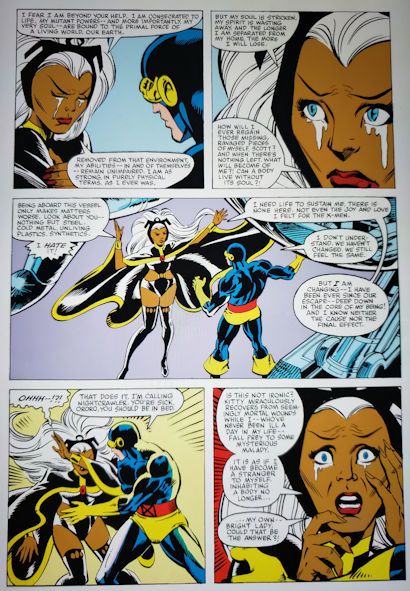
The following issue addresses the X-Men, on the run from the Brood, as they gradually come to terms with what“s been done to them. Claremont lays down several clues for Cyclops to follow as he gradually pieces together what really happened, forcing Logan to admit the truth. The Brood“s reluctance, Kitty suddenly being miraculously healed after an almost deadly spacewalk, Storm“s unease and spiritual conflict within herself, and Logan“s anger and silence all serve as smaller pieces to a larger puzzle. Moreover, we see that Carol has been changed because of the Brood“s experiments, recharging her powers and turning into Binary. Although Carol is portrayed mostly as a woman running with the X-Men, contributing with her skills as a spy, she“s jump-started into a uniquely powerful being.
Binary always struck me as a missed opportunity as a character, either because of disinterest or because later writers were nostalgic for the 70“s Carol. Her power as Binary is quite more interesting than Carol“s standard power set, drawing power from a white hole and physically becoming one with the universe. She“s also very powerful, which can be challenging to write for, but no less than many other cosmic-level characters in the Marvel stable. This is another reason why Claremont remains one of her best writers, as he moved her character forward from a difficult period after her time with the Avengers. He may be the one writer who helped her move on from the past, both as a character and in terms of her personal narrative. Unfortunately, she was never used consistently since then, often being regressed back to Ms. Marvel levels as the plot required it. In any case, this story is where she was used most to her potential as Binary, powering the starship to enable the team“s escape as well as destroying many of their Brood attackers.
Another character who struggles with the situation the most is Storm. Claremont notes that Ororo is most out of her element in space, especially in this situation. Her power is most uncontrollable, as she doesn“t have access to the elements in deep space. She“s surrounded by artificial things, cut off from the nature that she loves, and she is at her weakest. Moreover, she“s becoming more sensitive to the life inside her, the product of the Brood implantation, and she is uncertain about what to do. Ororo is attuned with life and she is a nature goddess, but if the Brood inside her lives, she faces her own death. It“s a no-win scenario for her morally””if she kills the Brood embryo, she survives, but she will have broken her pledge to honor all life. If the Brood win, she dies, and very probably many others as the Brood will kill to advance its own species. She feels broken spiritually, as the Brood is in conflict with her very nature, and the surroundings do little to improve Ororo“s spirits. It“s a fascinating situation that Claremont has dropped her in, and it pushes her to grow with her final choice in this arc.
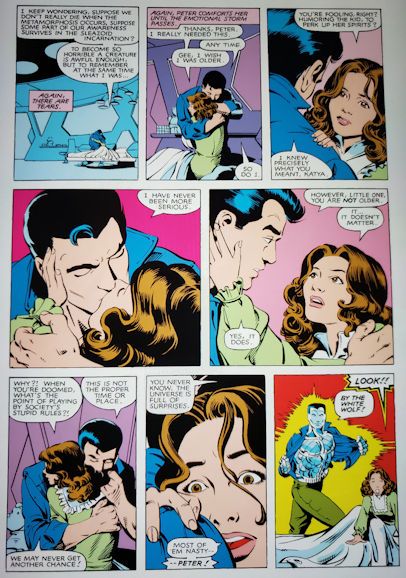
Logan“s revelation ends up shaking everyone with the truth. All of the X-Men struggle with it in various ways, and every character is on a different stage of coping with loss. Unfortunately for the X-Men, Carol responds with anger, as she realizes what the Brood have done to her. The issue ends as Carol blasts her way out of the ship as Binary, determined to avenge the Brood for what was done to them. Meanwhile, the ship gets slammed with explosive decompression as Carol makes her forceful exit. It“s a thoughtless act by Carol, even if her rage is understandable, though it makes a good dramatic cliffhanger between issues.
At this point of the Brood Saga, the art style changes again, as Dave Cockrum gives way to Paul Smith. Cockrum had already done two successful runs on Uncanny X-Men, and this would be his last. According to Louise Simonson, who was editor on the book at this time, Cockrum “left to write and draw The Futurians, the tale of eight genetically super-powered humans, for Epic, Marvel“s new, mostly creator-owned graphic novel imprint.”“ At the time, Epic Comics was a growing imprint for creator-owned projects at Marvel, edited by Archie Goodwin and Al Milgrom. Jim Starlin had launched his own Dreadstar series through Epic, and other established creators like Steve Englehart, Steve Gerber, Doug Moench, Paul Gulacy, and J.M. DeMatteis had been involved as well. Even Chris Claremont himself would write projects for Epic, including The Black Dragon and Marada the She-Wolf, both illustrated by John Bolton (who would go on to draw the Classic X-Men backup stories a few years later). The X-Men“s loss was Epic“s gain, though he was not done with the X-Men yet; Cockrum would return to write and draw a Nightcrawler limited series years later.
I“ll have more to say about Smith once we discuss the “From the Ashes”“ period, where Smith truly begins to blossom as the series artist on Uncanny X-Men. At this stage, Smith does a capable job of finishing the story that Cockrum began, though their visual approaches are uniquely different. Paul Smith was an artist that came from the world of animation, and he brought more realistic models as well as a strong sense of visual storytelling. With these issues, it“s clear that there was a learning process involved for Smith (Louise Simonson later admitted that he was asked to draw a difficult script), and he doesn“t truly come into his own until after the conclusion of the Brood Saga. At the same time, he does fine work in the quieter, character-driven moments, which Claremont heavily relies on before the final confrontation with the Brood.
Uncanny X-Men #165 allows Claremont to explore his deeper themes and the character questions he“s concerned with. After sealing the hole made by Binary on her way out of the ship, the X-Men are struggling with their own mortality in different ways. Scott is somewhat beginning to see Logan“s point of view, as he reluctantly agrees with Logan and Lilandra in striking back at the Brood. Storm is struggling alone with her decision whether or not to kill the Brood egg, and in a way it echoes the struggle of a young mother about whether or not to carry her child to term. It“s uncertain whether Claremont does so intentionally, but his language evokes that line of thinking, treating Ororo as the mother figure among the X-Men. Peter and Kitty turn to each other for comfort, and in a moment of desperation, thinks to give herself to him physically, only for him to decline. These are brief glimpses in the lives of the X-Men, which they believe may well be their last. They embrace their possible deaths as X-Men and as heroes, refusing to give in to despair even against a seemingly hopeless situation.
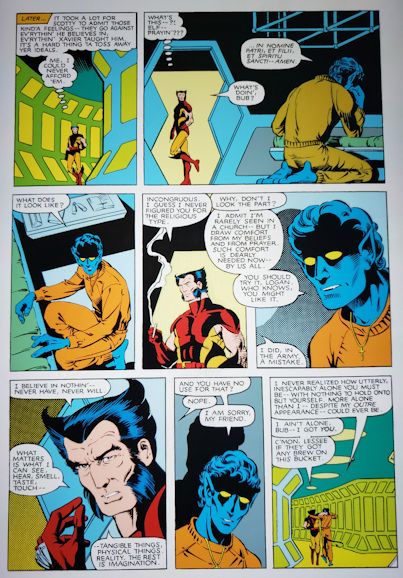
One standout moment among these glimpses is a brief scene with Wolverine and Nightcrawler where they debate about faith. As a devout Catholic, Kurt turns to his God for support and comfort in the darkness, and so he doesn“t feel alone in the universe. He then suggests that Logan should try faith, reasoning that he might learn to like it. Logan counters with the following: “I did, in the Army. Big mistake. I believe in nothin“””never have, never will. What matters is what I can see, hear, smell, taste, touch””tangible things, physical things. Reality. The rest is imagination.”“ Logan relies on his senses to determine what“s real, and it“s a reliance that becomes sorely tested following the Mutant Massacre. The contrast between that and Kurt“s acceptance of a higher power is a strong point of difference between them, but they strengthen each other through their different points of view. Their friendship becomes stronger because their different views test each other, and they learn to reconcile those differences in a positive way. This is a memorable scene between the two, hitting to the core of who both men are and why they“re such good friends. Very likely, this scene influenced the X-Men: The Animated Series episode “Nightcrawler”“, which also relied heavily on Kurt“s differences with Logan on matters of faith.
Eventually, Ororo manages to destroy the Brood egg, though it nearly destroys her. She finds salvation with the arrival of an Acanti whaleship, which performs a rendezvous with the X-Men“s ship. In the end, Ororo makes the only logical choice in this situation by destroying the Brood inside her, even though it“s against her belief in the sanctity of life. Not only would the Brood have destroyed her very essence, it would also possibly have caused the deaths of countless others, including the people she loved most, had it lived. The Brood is a being of evil, devoted to the propagation of its species at the expense of all others, and so Ororo has no other choice but to end its life to save others. However, this is a decision that shapes who Storm becomes in later years, becoming more the hardened and ruthless Ororo that she becomes during her “Mohawk”“ period.
This leads to the conclusion of the main Brood arc, resolving the main set-pieces and putting an end to the space epic. Much of the issue deals with the truth behind the Acanti and their relationship with the Brood; they are opposing forces that the Brood prey upon for space travel. However, the Acanti carcass on the Brood world from the first part was the Prophet-Singer of the Acanti, the spiritual leader of their people. His soul is bound to the body, unable to migrate or find rest as long as the corpse is not destroyed. Furthermore, the Acanti who saved Ororo was an Acanti child, a young Prophet-Singer who needs someone to provide guidance until he comes of age. From there, the X-Men resolve to their true purpose””not to cause death, but to save lives, and they resolve to save the elder Prophet-Singer and the Acanti people.
The rest of the issue is devoted to the X-Men“s invasion of the Brood world and the salvation of the elder Prophet-Singer. As is often the case with the X-Men, everything goes according to plan until things go badly wrong. The X-Men are defeated in part by the betrayal of Cyclops, whose Brood hatchling begins to take over his body. However, Kitty manages to escape thanks to the arrival of a certain alien dragon, as well as the soul of the elder Prophet-Singer. In the end, the X-Men are cured of the Brood infection by the Prophet-Singer, though it“s ultimately a very close call for them.
As one might guess, the alien dragon that helped Kitty is none other than Lockheed, who first befriends Kitty in this issue. We do not learn more about him, including even his name, until a certain Kitty-centric story a few issues later. One of the few flaws of the Brood Saga is that Lockheed“s presence feels tacked on, as though Claremont and Paul Smith had only thought of him at that moment. Had Lockheed been a planned character, no doubt Claremont would have established him much earlier, probably in the first part where we see the Brood world for the first time. It“s possible that he was created for this issue, and then grew into a more permanent character over time. It could even be that Paul Smith designed him for this issue, and Claremont decided to keep him. In any case, the introduction of Lockheed feels more like a whim of the creators than any type of long-term plan for him or Kitty. In any case, it“s difficult to imagine Kitty without her pet dragon nowadays and he“s more than contributed to Kitty and the X-Men over his long years as their pet.
In any case, the X-Men are rescued by the Starjammers and the team makes their return trip back to Earth. The finale deals with the team“s realization that Professor Xavier was possessed by the Brood, making the Brood a highly dangerous opponent. Moreover, Xavier has recruited a new team of young students””the original New Mutants. At this point, the team has not expanded its membership yet, and they only include the first five members: Dani Moonstar, Sunspot, Cannonball, Karma, and Wolfsbane. The X-Men burst in through the front door of the mansion while the kids are watching TV, leading to a classic “misunderstanding”“ battle between the X-Men and the New Mutants. Of course, the New Mutants are drastically unprepared to fight the much more seasoned X-Men and they“re overwhelmed at first”¦ until the arrival of a fully Brood-controlled Xavier. The New Mutants realize what“s happening and join forces with the X-Men, and they overcome the possessed Xavier between the combined might of the two groups. The Brood is destroyed, and with the help of Moira MacTaggart and the Starjammers“ medical technology, Xavier“s mind is transferred to a clone body, saving Xavier“s life and allowing him to walk again.
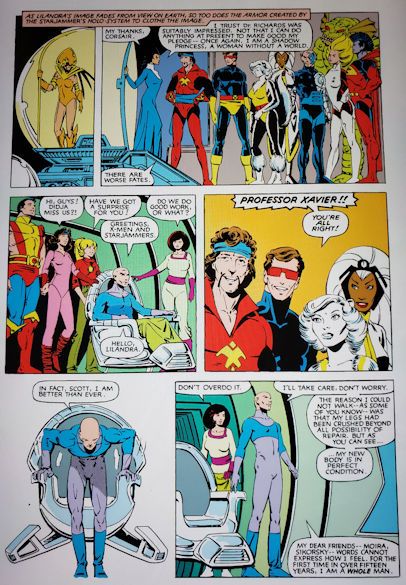
Although this does not seem like a big deal by today“s standards, as it“s been done several times since, Xavier regaining the ability to walk was a very new thing at the time. Furthermore, it is unlikely anyone thought about disabled representation the way they would today. Perhaps Claremont was thinking of the story possibilities of such a change, and how it would affect Charles and those around him. Even then, Xavier doesn“t immediately go back to walking like normal, since he initially dealt with psychosomatic issues and physical training before he was truly healed. Claremont gradually has Xavier overcome these problems before he returns to his feet, which feels more natural and progressive and remains true to Claremont“s long-form character style.
Claremont also turns his attention to other story threads, including some he would visit with Paul Smith in what would become the “From the Ashes”“ arc. Corsair offers Scott the chance to meet his grandparents, a chance that Scott gladly accepts. Gladiator arrives aboard the Starjammer to meet with Lilandra, which sets up her involvement in the Trial of Galactus in John Byrne“s Fantastic Four. Finally, once Xavier can walk, he“s left to address the question of what to do with the New Mutants, and also with Kitty“s status now that there“s a junior team.
Xavier makes his decision. From this point forward, Kitty Pryde gets a demotion. She“s to be sent down to the New Mutants, effective immediately. Xavier affirms that his decision is final, and that he will not change his mind. However, he hasn“t reckoned with the stubbornness of Kitty Pryde. The two lock horns in the following issue, a well-known story that could only be aptly titled”¦ “Professor Xavier Is a Jerk!”“
Regrettably, we will not be dealing with that story immediately, though that will come soon enough. Next time, we“ll be looking at the return of Dracula and the death of Rachel van Helsing. We“ll also look at some of the X-Men“s most classic stories, including Wolverine“s trip to Japan courtesy of Frank Miller and one of the greatest stories in the canon, God Loves, Man Kills. Along the way, we“ll also discuss the Extended Cut of GLMK and how that affects the legacy of this classic story.
Author Profile
- Steve Sellers had been a fan of superheroes ever since Superman: The Movie. But it took the JSA, the Legion of Super-Heroes, Dragonlance, Lord of the Rings, Twilight Zone, and Chris Claremont's legendary run on the X-Men to make him a writer and a longtime fan of comics, fantasy, and science fiction. Steve is the co-creator of WHITE DRUID & MICHAEL NERO and GUARDIANS OF ELAYIM for Omen Comics, and he is also the creator of BLITZ and SHOCKWAVE for Revelation Comics (an imprint of Omen Comics).


